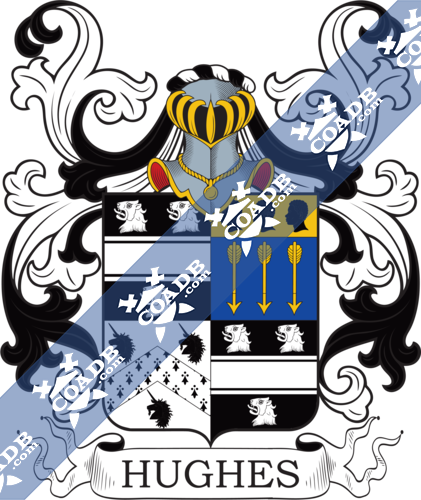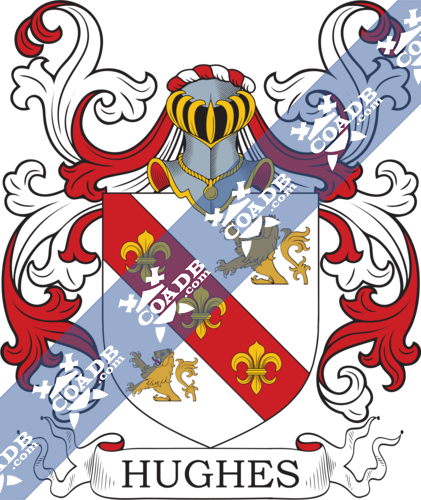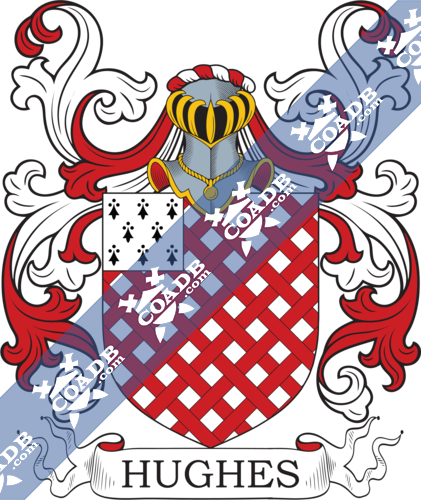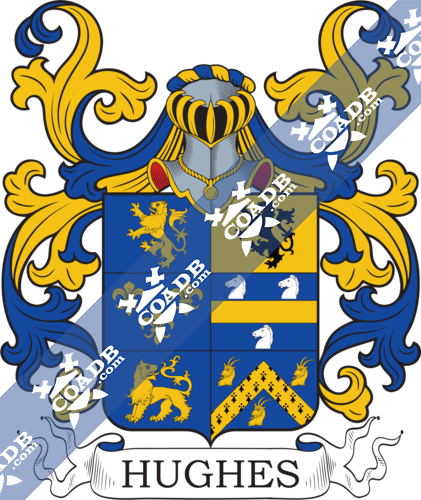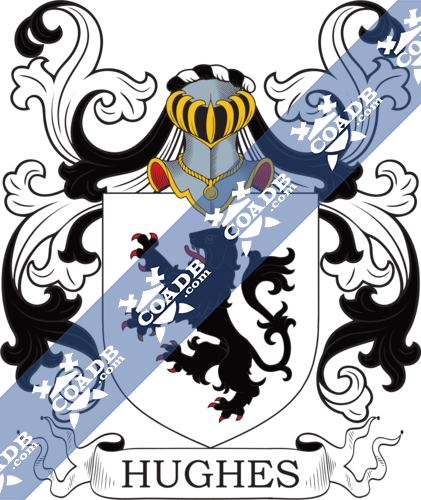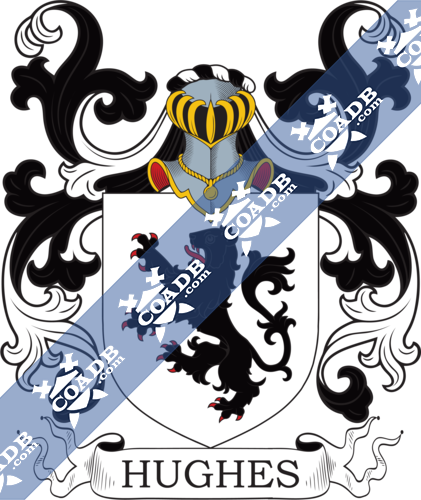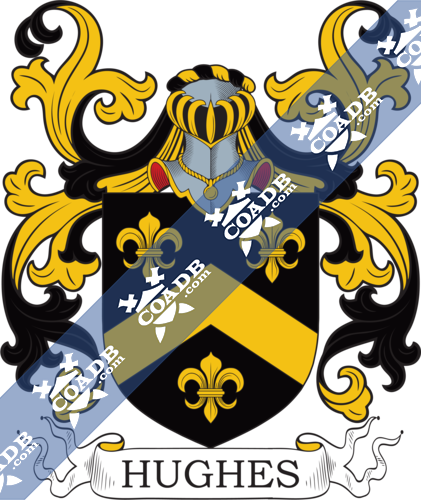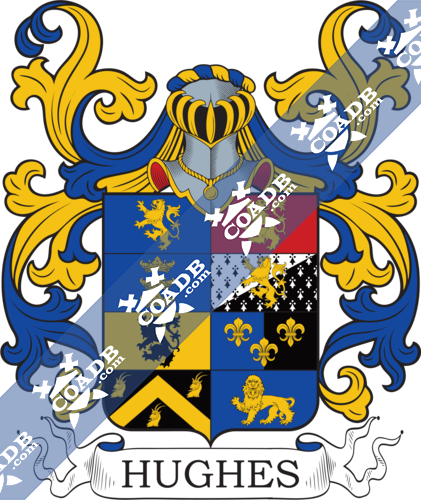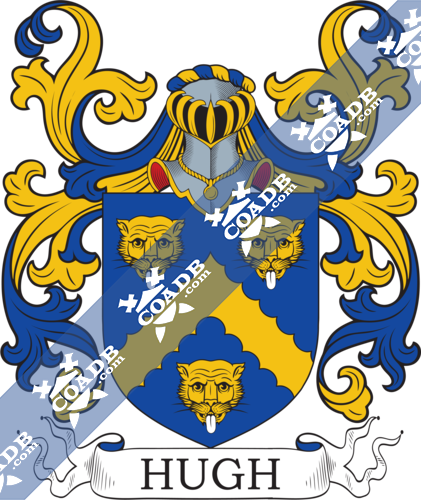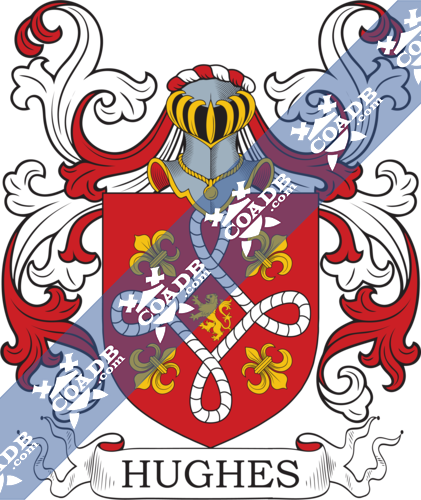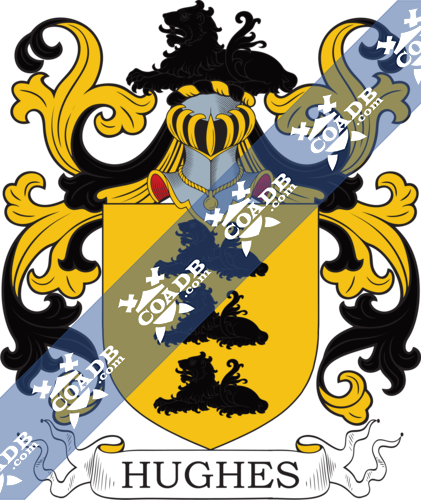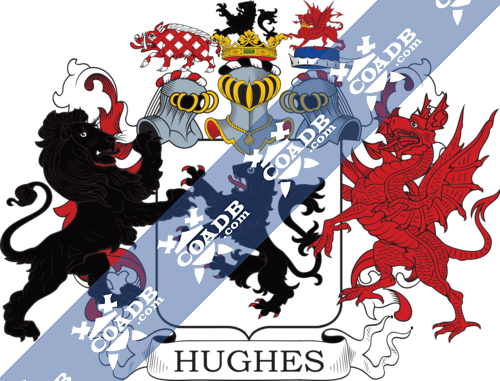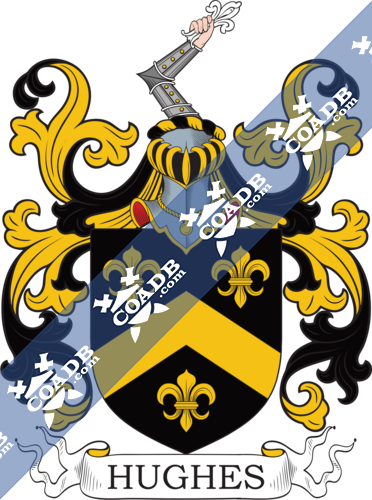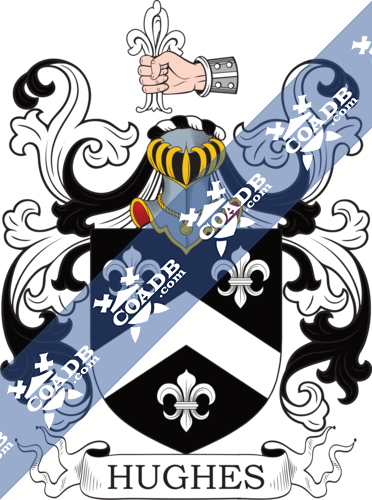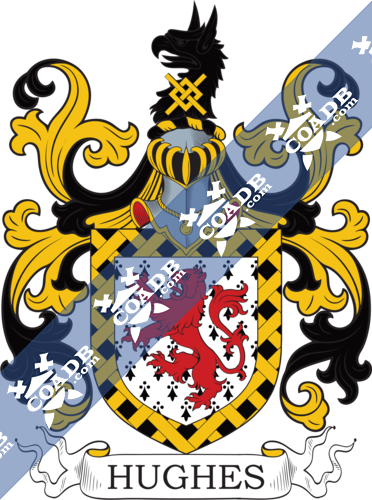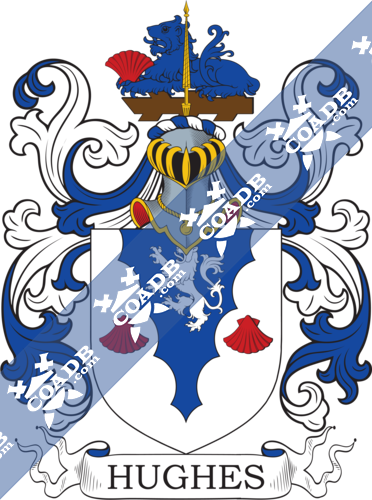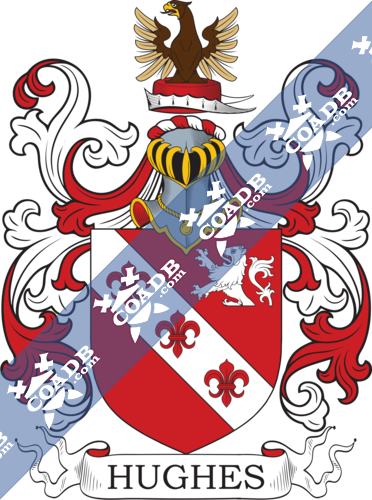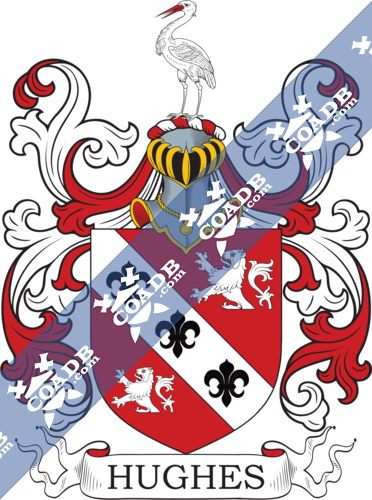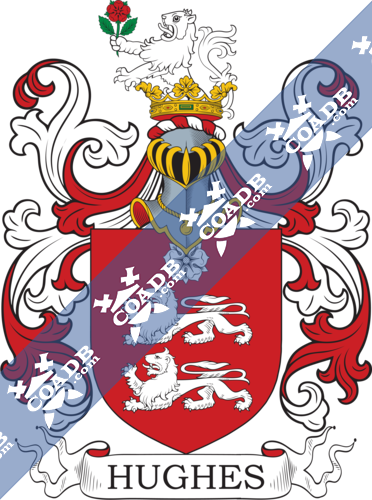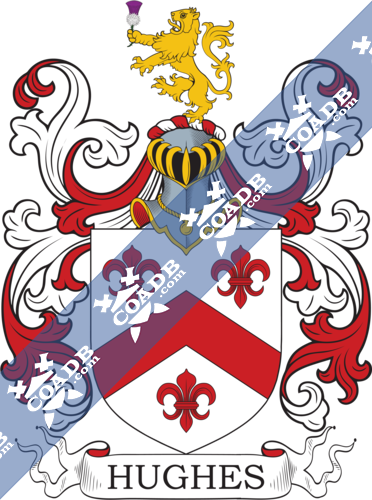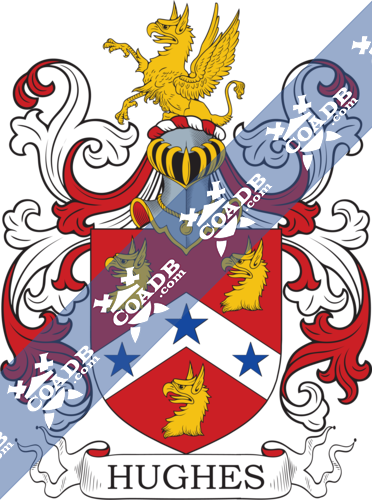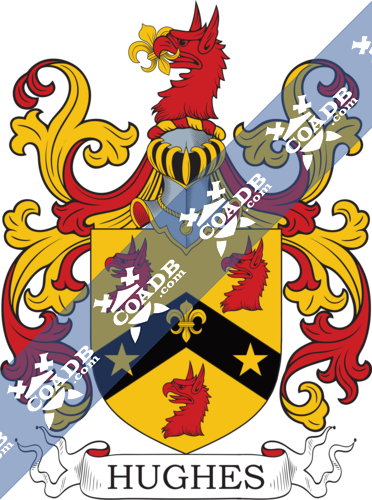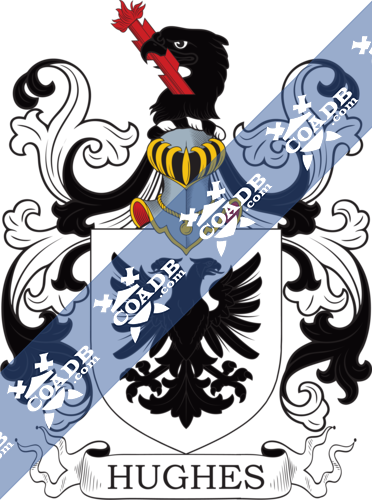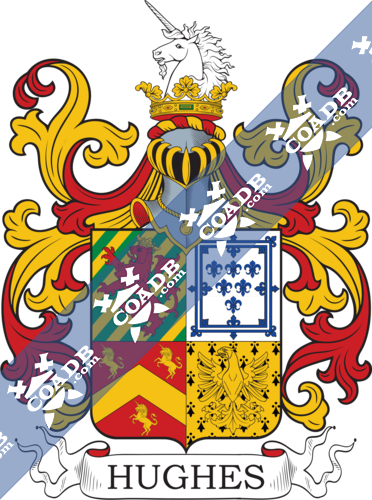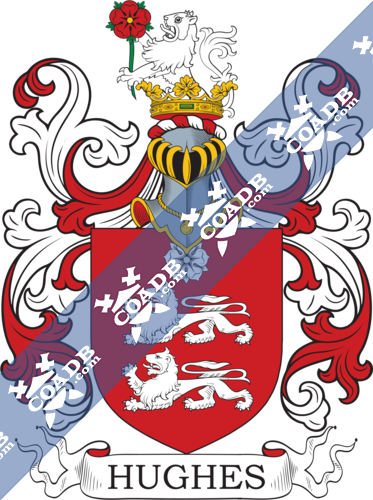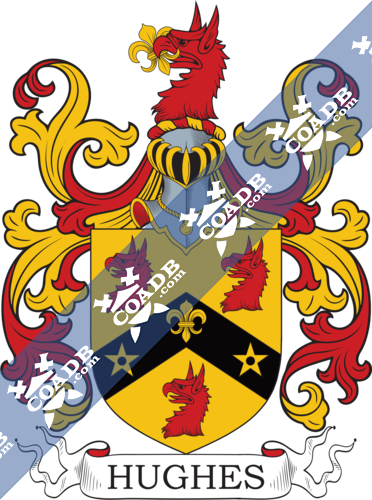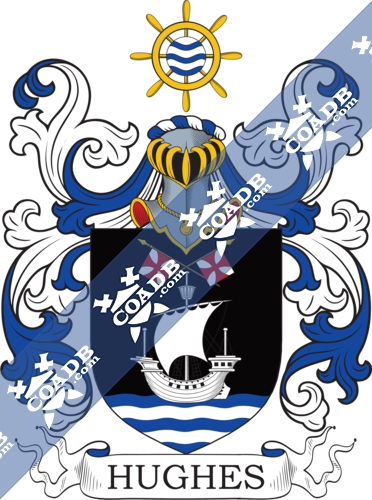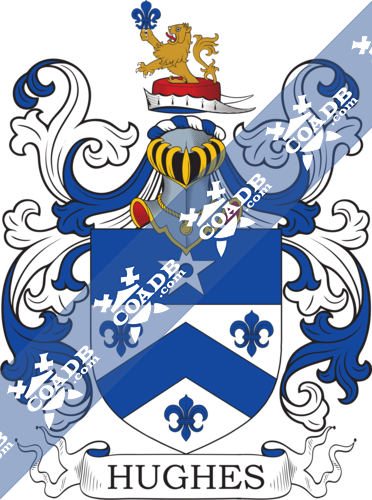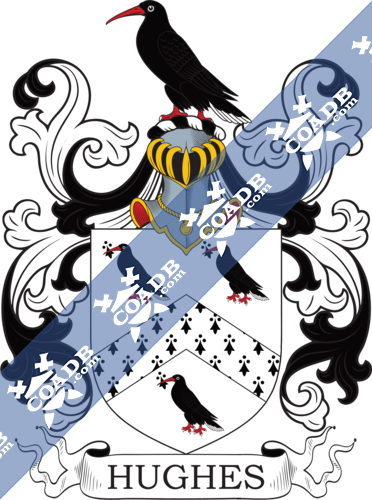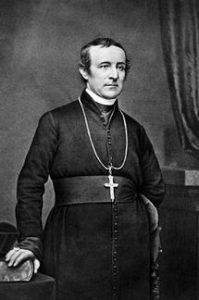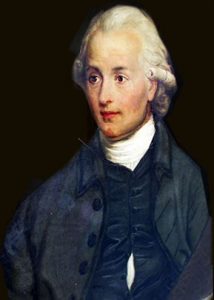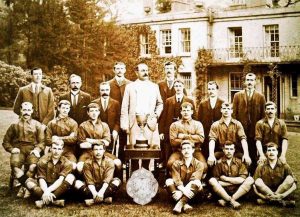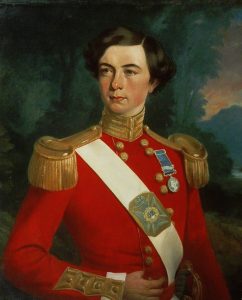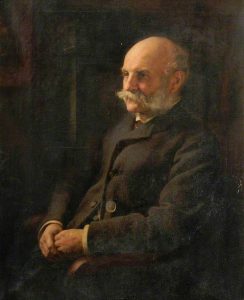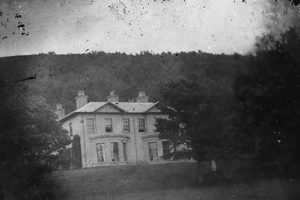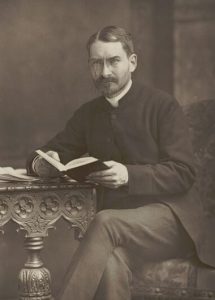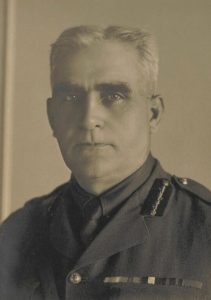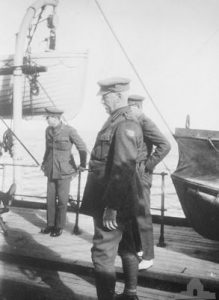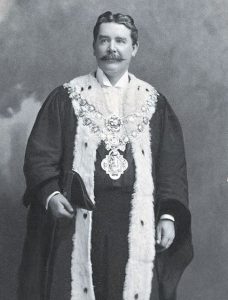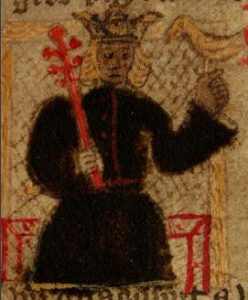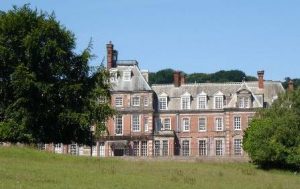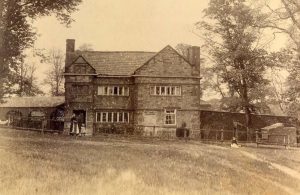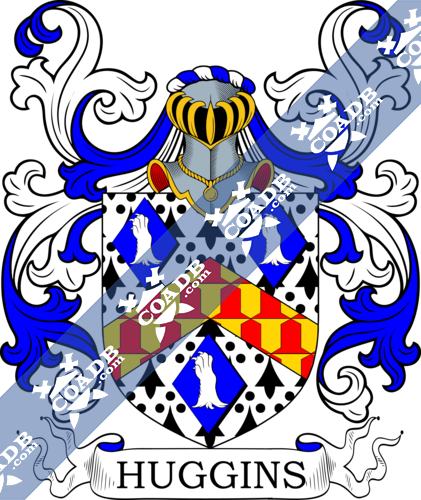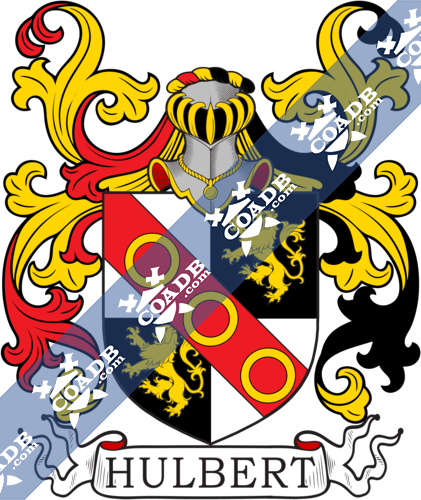Hughes Family Crest, Coat of Arms and Name History
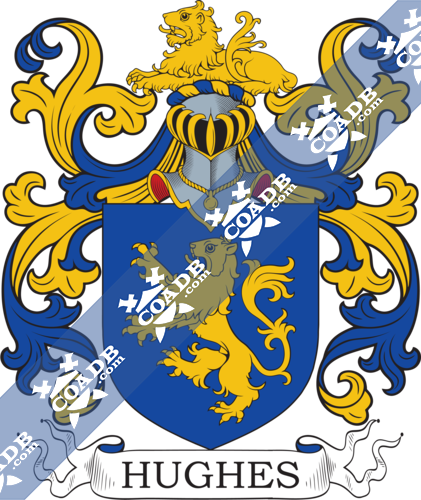
Hughes Coat of Arms Gallery
Don’t know which Coat of Arms is yours?
We can do a genealogical research. Find out the exact history of your family!
Learn MoreHughes Surname Name Meaning, Origin, History, & Etymology
The ancestors of this family were of Welsh Brythonic-Celtic heritage, and trace all the way back to the early ADs. However, they did not acquire the surname Hughes until after the Norman Invasion of 1066 AD, when it was brought into the British Isles by the Norman-French invaders/settlers. The name was present in medieval France in the regions of Brittany and Languedoc. There it derived from the German personal name Hugo, which itself derived from the Old German word hug, meaning bright in mind or bright in spirit, or intelligent. One source asserts the personal name Hugh derives from the world hougen, meaning cutter or slasher. Another source said the name Hugh denoted comfort.
This primarily Welsh surname (as well as other areas of Brythonic Britain) originated as a patronymic form of Hu or Huw, meaning “son of Hu”, a personal (first) name meaning fire or inspiration. In Ireland, this last name evolved from the ancient Irish name Ó hAodha, meaning the descendant of Aodh, which became Anglicized to Hugh. It should also be noted it may also be the unrelated Picard variant Hugh (Old French Hue) of the Germanic personal name Hugo.
In Ireland and Scotland, the name became both Aodh and Eoghann. In Wales and other Celtic lands, the name derives from the Old Celtic words hu or hew, meaning fire or inspiration.
Eanna Ceannsalach (born around 400 AD), King of Leinster, had seven sons, the last of which was Deadhac, who was the ancestor of the O’h Aodha family, which was eventually Anglicized to Hay, Hayes, Haiz, Hughes, Hewes, O’Hay, O’Hea, and O’Hugh. One source states in Gaelic, the name is Aoidh, which meaning affability, a guest, a stranger. The words hu and ho suggest highness
The personal name Hugh also lends itself to numerous other British surname, such as Hewett, Howitt, Hewlett, Howlett, Hewling, Howling, Huggin, Huckin, Houchin, Howchin, Hutchins, and Hutchinson. The personal name Hugh was also born a variety of Catholic saints such as St. Hugh of Cluny, St. Hugh of Grenoble, and St. Hugh, Bishop of Lincoln.
In Ireland and Scotland, it is also can Anglicized version of the Gaelic surname MacAodha. In Wales, it is also a variant of the surname Howell.
Spelling Variations
Common spelling variants or names with similar etymologies include Hughs, Hugh, Hughe, Hues, Hews, Hewse, Heughes, Heugh, Hughues, Huighes, Hughess, Huse, and Hewes. Hewes is a misspelling of Hughes. In the great Scottish family of Dalrymple the Christian name Hugh has generally been spelt Hew. Similar European names include Hugi (Norse), Huhs (Danish), and Hugues (Dutch).
Popularity & Geographic Distribution
The last name Hughes ranks 83rd in popularity in the United Status as of the 2000 Census. The name ranks particularly high in the following eleven states: Pennsylvania, Ohio, Delaware, Tennessee, Virginia, Alabama, South Carolina, Indiana, Kentucky, Mississippi, and Arkansas.
The surname Isaac frequency/commonness ranks as follows in the British Isles: England (28th), Scotland (65th), Wales (9th), Ireland (62nd) and Northern Ireland (21st).
In England, it ranks highest in Cheshire. In Scotland, it ranks highest in Lanarkshire. In Wales, the surname Hughes ranks highest in the following counties Anglesley, Caernarfonshire, Denbighshire, Flintshire, Merionethshire, and Montgomeryshire. In Ireland, it ranks highest in Monaghan. In Northern Ireland, it ranks highest in county Armagh.
The name is also present throughout the remainder English speaking world: Canada (159th), New Zealand (64th), Australia (54th), and South Africa (469th).
The 1890 book Homes of Family Names by H.B. Guppy, states the following in regard to this surname: “Very frequent in North Wales and fairly numerous in South Wales, Herefordshire, and Shropshire. Advancing into England in a south – east direction towards the metropolis, it has obtained a firm hold in Wilts, whilst Hants and Oxfordshire contain its outposts”.
Early Bearers of the Surname
The earliest known bearer of this surname was Thomas Hughes who was documented in the Pipe Rolls of 1327 AD. The Hundred Rolls of 1273 AD, a census of Wales and England, known in Latin as Rotuli Hundredorum lists one bearer of this surname: Eddie filius (son of) Hugh. John Hughe was recorded in Kirby’s Quest in county Somerset during the first year of the reign of King Edward III (1327 AD). Richard Hewes was documented in the Valor Ecclesiasticus. Richard Hewes was documented in the Calendar of Proceedings in Chancery. An early baptism involving this name was Anne, daughter of Maurice Hughes, at St. James Clerkenwell in London in 1586 AD. An marriage involving this surname was Stephen Hughes to Cattrin Daniell in Swansea, Glamorgan, Wales in 1670 AD.
Hughes of Ireland
In his 1895 book, Genealogy of Irish Families, in a section titled “The O’Heay, Hay, or Hughes Family”, John Rooney writes “This family, whose name is variously written Hea, Hay, Haves, and Hughes, is descended from Milesius. King of Spain, through the line of his son Heber. The founder of the family was Cormae Cas, son of Olliol Ollum, King of Munster, AD 177, and his consort, Sabia, daughter of Con Kead Caha, or Con of the Hundred Battles, King of Ireland. AD 148. The ancient name was Ease and signifies “Old.” The possessions of the sept were located in the present Counties of Cork, Limerick, and Meath. In the last-mentioned county the O’Hayes, or O’Hughes, were Chiefs of Odhbha (probably Odra or Oddor, in the barony of Skrine, near Tara). The O’Hayes, or O’Hughes, were also Chiefs of Fearnmhoighe, or Fernmoy, a district in the County Down, on the borders of Antrim in the barony of Lower Iveagh. There were other chiefs and clans of this name in Mayo and Sligo and the O’Hughes were Chiefs of Esnardh, now Ballyshannon, in the barony of Tir Hugh, in the County of Donegal. The name—in Irish O’Haedha—is very common throughout the province of Ulster, where it is Anglicized Hughes. In the south of Irelaud it is variously Anglicized O’llea, O’Hee, O’Hay, and Hayes”. The claim about descent from King Milesius is dubious given said king is considered to be mythical by most historians, and the author of the book makes this same claim in regard to many other Irish surnames. He discusses one notable at some length, John Hughes, the first Archbishop of New York, from the northern branch of this family, stating “He was one of the greatest prelates of the Church in America. He succeeded in having the existing school system modified in favor of Catholics and he afterward laid the permanent foundation of the parochial-school system. He was the recognized exponent of Catholic thought in his day and the organization and extension of the Church, not only in New York, but throughout the United States, was largely due to his energy and statesmanlike ability. By his firmness and decision during the Know-Nothing outbreak, he saved New York from murder and arson, and in 1803 he materially assisted in quelling the draft riots. At tin- outbreak of the Mexican War he was requested by the United States Government to accept a diplomatic appointment with a view of bringing about a restoration of peace, and during the Civil War he was sent to Europe by the Government on a diplomatic mission to counteract the unfriendly feelings that had been excited by Confederate emissaries in certain European cabinets, especially that of France”.
Hughes Family Tree & Hughes Genealogy
The famous genealogist Bernard and John Burkes books “The Landed Gentry” and “Peerage, Baronetage & Knightage” discusses ten different branches of the Hughes family tree, families that were landed or noble. Each is discussed in some detail below.
Hughes of Kinmel
Hugh Robert Hughes, Esquire of Kinmel, county Denbigh, was Lord Lieutenant of Flintshire and was born in 1827. In 1853, he married Lady Florentia Emily, daughter of Henry Thomas, the 1st Earl of Ravensworth, and had seven issue with her: Hugh Seymour Bulkeley Lewis (1862), Henry Bodvel Lewis (1864), Elizabeth Bronwen, Mary Florentia, Frances Ann, Eleanor, Horatio Maria Susanna, and Anne Gwendolen. Burke traces the lineage back to Hwfa Ap Cynddelw (born 1085-1169 AD), Lord of Llys Llifon, in Anglesey (living in the time of Owen Gwynedd, Prince of North Wales, who was the founder of the first Noble Tribe of Wales. His office was to bear the Prince’s coronet and place it on his head when the Bishop of Bangor anointed him. He had residence at Presaddfed, in Anglesey, and he possessed other lordships which are mentioned in the “Extent to North Wales”, which were divided among his five sons: Mathusalen, Cyfnerth, Ievan, Iorweath, and Blettrws. He married Ceinfryd, daughter of the Chief of the 15th Noble Tribe, and had a son with her named Mathusalem. Mathusalem had two sons: Iorwerth (whose daughter was named Gwenhwfa married Llewellyn ap Madoc ap Einion) and Meredith. His son Meredith had two sons: Iorwerth and Griffith. His son Iorwerth ap Meredith had three sons, one named Meredith. This Meredith had sons. One son was named was named Griffith ap Iorwerth, who married Gwenllian, daughter of Ririd Flaidd, with whom he had six issue: Iowerth, Griffith Vychan, Llewellyn, Sir Howel y Pedolau, Rhys, and Gwenllian. His son Iorwerth Ap Griffith married Gwladys, daughter and heir of Howel Goch ap Iorwerth ap Cagwgan and had several children with her. The eldest son was Iorwerth Ddu Ap Iorwerth, who married Gwenllian, daughter and heir of Meredith benhir ap Meredith ap Llewellyn, and had issue with her. The eldest son of this marriage was Howe lap Iorwerth Ddu, who married Angharad, daughter of Howell ap Crynrige Vychan of Hiraethog and had issue with her, including: Hwlkin, Rhys, Iorwerth, Llewellyn, Kwnnws, and Margaret. The following is a list of descendants from the eldest son, Hwlkin ap Howell (who was alived during the 21st year of the reign of King Richard II of England, which was 1398 AD), in each successive generation:
Llewellyn ap Hwlkin (lived during the reign of King Henry VI)
Hugh Lewis, Esq. of Presaddfed (lived in 1485)
John Lewis, Esq. of Presaddfed (married Elizabeth Vaughan)
Hugh Lewis, Esq. of Presadded (married Agnes Griffith)
William Lewis, Esq. of Presadded (Justice of the Peace, High Sheriff, & Member of Parliament)
Hugh Lewis Esq. of Presadded (married Margaret ap John ap Rhys)
John Lewis Esq. of Presadded (High Sheriff of Anglesey 1606, married Anne Owen)
John Lewis Esq. of Presadded (High Sheriff in 1618, married Catherine Lloyd)
Anne Lewis (had two sons who became Viscount Dungannon, but died without heirs)
line passed to William Lewis (High Sherrif in 1549, married Elin ap Hugh ap Gwyn)
Robert Lewis, Esq. of Cemlyn (born 1599, married Gaynor Roberts)
William Lewis of Cemlyn (died 1676, married Anne Bulkeley)
Ambrose Lewis (died 1729, Rector of Llanrhyddlad)
Robert Lewis (M.A. of Cemlyn, Rector of Trefdraeth, married Margaret Price). His daughter was:
Mary Lewis, daughter of Robert and co-heir to her uncle William from whom she inherited Cemlyn and Llysdulas. She married Reverend Edward Hughes in 1765, who was the eldest son of Hugh Hughes of Lleiniog in Anglesey, and had the following issue with her: William Lewis (1st Lord Dinorben), Hugh Robert (born 1774), James (colonel in the Army, married Fanny Stanhope), Margaret (married Owen Williams of Temple House), Anne (married Sir Robert Williams, Baronet of Penrhyn), Eliza, Martha (married Cynric Lloyd and later Sir Henry Wyatt), and Mary Hester. The eldest son was William Lewis Hughest who was born in 1767. He became a Member of Parliament for Kinmel Park, Dinorben and Llysdulas and was created Baron Dinorben in 1831. In 1804, he married Charlotte Margaret, daughter of Ralph William Grey of Backworth, and had ten children with her: Edward, William Lewis Hughes (2nd Baronet), Charlotte Mary (married Sir Richard Williams Bulkeley), Frances Margaret (married Allan Legge), Martha Mary, Eliza Anne, Laura, Caroline Anne, Emily, and Augusta. He later married Gertrude, youngest daughter of Grice Smyth, and had two daughters with her: Gertrude and Gwen-Gertrude. Lord Dinorben died in 1852 and was succeeded by his only surviving son, William Lewis. William Lewis, the 2nd Baronet, was born in 1821 and died in 1852, whereupon the title became extincy. The estates devolved to his cousin and male heir, Hugh Robert Hughest, Esquire of Kinmel and Dinorben (mentioned at the very beginning of this section. The Hughes Coat of Arms (erroneously called the Hughes Family Crest) was blazoned in heraldry as follows: Gules, two lions passant in pale and a rose in chief argent. Crest: Out of a coronet or, a demi-lion rampant argent holding between the paws a rose gules slipped vert. Motto: Heb Dduw heb ddim, Duw a digon. They were seated at Kinmel Park, Abergele and Glanywern, Denbigh.
Hughes of Sherdley Hall
Michael Hughes, Esquire of Sherdley Hall in county Lancaster was born in 1810. He became a Justice of the Peace and in 1859, he married Ellinor Mary, daughter of Admital Campbell of Ardpatrick, county Argyll, with whom he had one son, Michael James, born in 1861. The lineage of this branch of the Hughes family tree is related to that of Hughes of Kinmel, discussed in considerable detail in the proceeding section. Michael Hughes, Esq., son of Hugh Hughes of Lliniog, was born in 1752. He married Mary, daughter and heiress Reverend William Johnson of Prescot, by whom he acquired significant landed estates in county Lancaster. She died in 1798 without issue and he then married Ellen, daughter of John Pemberton of Sutton Place, and had issue with her: Michael, William, Ellen Margaret, Mary (married Reverend Stewart Majendie), and Emily. He passed away in 1825 whereupon he was succeeded by his son, Michael Hughes (mentioned at the beginning of this paragraph). The coat of arms for this family is blazoned in heraldry as follows: Gules, two lions passant in pale and a rose in chief argent. Crest: Out of a coronet or, a demi-lion rampant argent holding between the paws a rose gules slipped vert. They were seated at Sherdley Hall, St. Helens in county Lancaster.
Hughes of Plas Coch
William Bulkeley Hughes, Esquire of Plas Coch and Brynddu, was born in 1797 and was Justice of the Peace, Deputy Lieutenant, High Sheriff, and a Member of Parliament for the Carnarvon District of Boroughs. He first married Elizabeth, daughter and heiress of Jonathan Nettleship, Esquire of Mattersey Abbey, county Nottingham, and later, Elizabeth, daughter of William Donkin of Rothbury, Northumberland. The Hughes genealogy traces back to an ancient family deriving its paternal lineage from Llywarch ap Bran (1120-1155 AD), Lord of the Commot of Mena. From him descended Hugh Hughes, Esquire of Porthaml, son of David ap Hugh, the first person who assumed the family surname of Hughes. He rebuilt the family mansion, named Plas Coch (meaning Red Hall, from the color of stone used in the building), which was later renamed Porthaml Issa. He was High Sheriff for county Anglesey in 1581, 1582, and 1600, a bencher of Lincoln’s Inn, and Attorney General to Queen Elizabeth for North Wales, but he died in London. He married Elizabeth, daughter and co-heir of Simon Montague, and with her had a son and heir named Roger. Roger Hughes, Esquire of Plas Coch was Barrister-at-Law who married Winifred, daughter of David own, and had a son and successor with her named Hugh Hughes who lived in 1464, and with his wife Jane, had a son named Roger. This Roger was High Sheriff in 1685 and in 1667, he married Margaret, daughter and heir of Henry Jones of Plas-yn-Llangoed, and had children with her, including Hugh. Hughe Hughes, Esquire of Plas Coch, was High Sheriff in 1719 and he married Emma, daughter of William Griffith of Carrigllwyd, but he died without posterity. He was succeeded by his nephew, William Hughes, Esq. of Plas Coch and Plas-yn-Llangoed, who married Anna, daughter and heir of Fortunatus Wright of Liverpool and had the following issue with her: William Bulkeley, Reverend Hugh Robert, Robert (see Hughes of Plas-yn-Llangoed), Robert, John, Mary, Anne (married Richard Jones), Jane (married George Martin), and Margaret (married Captain MacDonald of Edinburgh). His son and heir was Sir William Bulkeley Hughes, Knight of Plas Coch who was born in 1766. In 1792, he married Elizabeth, daughter and co-heir of Rice Thomas of Coedhelen, and had the following issue with her: William Bulkeley, Rice Robert (Rector of Newborough and Vicar of Llanidan), Robert George (of Llyon, Holyhead, a Major General of the 52nd Foot, married Hannah Jordan), Elizabeth (married Pierce Wynne Yorke), Mary (married Osgood Gee), Ellen Catherine, and Sidney Jane (married Frederick Charlton Marsden). Sir William died in 1836 and was succeeded by his son, William Bulkeley Hughes. The Hughes Coat of Arms (erroneously called the Hughes Family Crest) is blazoned in heraldry as follows: Argent, a chevron ermine between three Cornish choughs proper, each holding in its beak an ermine spot. Crest: A Cornish chough proper. Motto: Duw a ddarpar I’r Brain.
Hughes of Plas-Yn-Llanngoed
Robert Jones Hughes, Esquire of Plas-yn-Llangoes in county Anglesey was Justice of the Peace, Deputy Lieutenant, and High Sherifif in 1845 and he was born in 1810. The lineage of this branch of the Hughes family tree is related to that of Hughes of Plas Coch. William Hughes, of Plas Coch, was successor in the estate of Plas-yn-Llangoed, and the impropriate rectory, advowson, and patronage of Lalniestyn, with the chapelries of Llangoed and Llanfihangel-tyn-sylw. His son was the Reverend Hugh Robert Hughes who passed away in 1804 and was succeeded by his brother, Robert Hughes, Esquire, a Lieutenant in the Royal Navy and High Sheriff of Angelesey. In 1815, he married Dorothy Philadelphia, daughter of Herbert Jones of Llynon, with whom he had the following issue: Robert Jones, William Henry (married Charlotte), Herbert Jones (Captain of the Edinburgh Artillery Militia, married Helen Hunt), Hugh Robert (married Catherine Greig), Dorothea Emma (married John Cattermole of Norfolk) and Mary Elizabeth (married Thomas Morris of Liverpool). He died in 1827 and was succeeded by his son, Robert Jones (mentioned at the beginning of this paragraph). This branch of the Hughes family tree bore the same arms, crest, and motto as Hughes of Plas Coch. They were seated at Plas-yn-Llangoes, near Beaumaris, Anglesey.
Hughes of Ystrad
Thomas Hughes, Esquire of Ystrad, county Denbigh, was Justice of the Peace and Deputy Lieutenant for counties Denbigh and Flint, as well as High Sheriff. He was born in 1799 and in 8127, he married Margaret, daughter of Robert Williams, Esquire of Pentremawr, county Denbigh and Dee Bank, county Chester, and by her, had the following issue: Hugh Robert (Major Royal Denbigh Rifle Militia who was born in 1835, married Susan Marian Townshend), Sarah Mary (married Henry Dobinson of Stanwix), Martha Elizabeth (married Henry S. Grubb of Clashleigh, Ireland), and Selina Margaret (married T. Augustus Greer of Clonmel). He was Steward of the Crown for the Lordship of Denbigh. Burke traces the Hughes ancestry back to Robert ap Hugh, a descendant of Iorwerth Sais, and from him descended Andrew Hughes, Gentelman of Segroyt, who lived during the reign of King James I of England (), who appears to be the first who assumed the family surname. He married Katherine Lloyd, of Brynlluarth, and was succeeded by their eldest son, Hugh. This Hugh Hughes married Grace, daughter of Evan Lloyd of Eriviatt, by whom he left issue Margaret (married Robert Price) and Evan. In 1685, the latter, Evan Hughes married David Roberts, Gentleman of Penyburn, St. Asaph, and had issue with her. One of these children was Hugh, his heir, who lived at Penybryn, and married Mary, daughter of Meriana Jones of Meriadog, with whom he had several children. The eldest son of this marriage was John, who he died and was succeeded by the second son, Reverend David Hughes, A.M. Rector of LLANDDOGET AND Vicar of Aghrim. He married Margaret, daughter of Edward Hughes of Keidiog, with whom he had a sons Hugh and Edward, as well as three daughters. His son Hugh Hughes, Esquire, succeeded his father, and in 1758, married Mary, daughter and heiress of Rice Roberts. He in turn was succeeded by his edlest son, John Hughes. This John was born in 1763 and in 1795, he married Mary, daughter and co-heir of John Matthews. He left three issue: Thomas (mentioned at the beginning of this paragrahph), Mary Ann, and Margaret (married Robert Read). The Hughes Coat of Arms is blazoned as follows: Or, three lions couchant sable. Crest: A lion couchant.
Hughes of Allt Llwyd
John George Parry Hughes, Esquire of Alltwyd in county Cardigan, was Justice of the Peace, Deputy Lieutenant, and High Sheriff. He was educated at Winchester and Brasenose College, Oxford. In 1869, he married Elizabeth Charlotte Mary, daughter of J.A. Lloyd-Philipps, Esquire of Mabws, and had issue with her: John Lloyd and Dorothy Edith. Burke traces the Hughes lineage back to William Hughes, Esquire of Rhos Tyddin, who was the father of William. This Reverend William Hughes of Glanravon was Vicar of Lanilar, who married Dorothy, daughter of Thomas Evans of Tymawr Talsarn, with whom he had a son and heir named John. John Hughes, Esquire of Glanravon, who in 1801, married Jane Edwards, daughter of Thomas Evans of Lanilar, and had issue with her: John (his heir), Jane (married Reverend John Jones), and Elizabeth (married John Syme of Edinburgh). His heir John was an Esquire of Allt Llwyd, Justice of the Peace, Deputy Lieutenant, and High Sheriff in county Caridgan who was born in 1805. John married Elizabeth, daughter of George William Parry, and had the following issue with her: John George Parry (mentioned at the beginning of this paragraph) and William Thomas. The Hughes Coat of Arms (mistakenly called the Hughes Family Crest) has the following heraldic blazon: Argent, a chevron between three fleurs-de-liz azure, on a chief of the last a mullet pierced of the field. Crest: On a chapeau gules turned up ermine a demi-lion rampant holding in its dexter paw a fleur-de-lis. Motto: Y cyfiawn sydd hy megis.
Hughes of Tregib
John William Morgan Gwynne Hughes Esquire of Tregib, county Carmarthen was Justice of the Peace, Deputy Lieutenant, and Captain of the 13th Light Dragoons who was born in 1819. He married Mary, daughter of William Howell, but did not have issue with her. He secondly married Mary Lewis of Llanelly, and had seven issue with her: John Williams Gwynne, William Morgans Garnons, Richard Jones, Fanny Gwynne, Elizabeth Mary, Margaretta Caroline, and Maude. This family descends from Gwynvard Dyfed (who lived around 1038 AD). Edward Hughes, of Penymaes in county Caermarthen, was High Sheriff in 1550. He married Mary, daughter of John Bowen of Kittlehill, and he had three sons with her: Daniel (his heir), Rowland (married Mary Vaughan), and John Samuel. His eldest son and heir, Daniel, married Mary, daughters of James Davies of Bigelly, and had a son with her named Arthur. This Arthur Hughes, Esquire of Penymayes, married Judith, daughter of Reverend William George, with whom he had a son named Daniel. Daniel Hughes, Esq. of Penymaes, living in 1700, married Mary, daughter of Morris Lloyd, and later Mary, daughter of William Morris. He had several daughters with her, as well as son sons: Arthur, Lewis (married Frances Bowen), and James. His eldest son, Arthur Hughes, Esq. of Penymaes, married Hester, daughter and heiress of Samuel Thomas, and had a son and heir with her named Daniel. Daniel Hughes was High Sheriff for county Caermarthen in 1708. He married Amy, daughter of Reverend Thomas Powell, Rector of Lalngunar, and had an only child and heiress with her named Mary, who married John Rees of Killymaenllwyd. The male line deolved to his cousin, James Hughes. James married Elizabeth, daughter of John Williams of Bwlehgwynt, and had five issue with her: Lewis, James (of Foord), John Williams, William (Captain of the Royal Navy), and Martha and Frances. His third son, John William Hughes, was Lieutenant of the 12th Regiment, Justice of the Peace, Deputy Lieutenant, and High Sheriff in Caermarthen in 1796-7, as well as a Colonel of the Royal Caermarthenshire Fusiliers. He inherited the Corngafr estates from his material uncle, John Williams. He married Elizabeth, daughter and heiress of Richard Gwynne, and had eleven children with her: John Williams, James (of Tymawr), William Garnons (Justice of the peace of Glancothic, Captain in the Royal Army), Richard Jones, Eliza Gwynne (married George Phillips), Catherine Jones, Ann (married Edward Price Lloyd of Glasnevin), Francis Justina Maria Jane Vaughan (married Henry Lawrence), Catherine Garnons (married Lyston Horton), Martha Sybill, and Beatrice Mansell. The eldest son, John William Gwynne Hughes, Esquire of Tregib, was Justice of the Peace, Deputy Lieutenant, and High Sheriff for Caermarthen in 1830. He married Margaretta Julianna, youngest daughter of Morgan Pryse Lloyd, and had eight children with her: John William Morgan Gwynne (mentioned at the beginning of this paragraph), Edward James (Captain 3rd Benegal Regiment), William Garnons, Reverend Richard Jones, Devereux David, Octavius Rudd, George Henry (Captain 23rd Royal Welsh Fusiliers), and Elizabeth Margaretta Catherine. The Hughes Coat of Arms is blazoned as follows in heraldry: Gules, a lion rampant or, in a true-love knot argent between four fleurs-de-lis, their stalks bending towards the centres of the second. Crests: 1st, A Talbot passant, for Hughes, 2nd; A goat passant, for Williams; 3rd, A raven proper, for Gwynne.
Hughes of County Wexford
Sir Frederick Hughes, Knight, was a Justice of the Peace, Deputy Lieutenant, Captain 7th Madras Cavalry, and Knight of the Royal Persian Order of the Lion and Son. In 1864, he married Emily, daughter of late William Kraeutler, and had one child with her, Frederic William Robert, born in 1868, who died as an infant. He later married Theodosia, daughter of Edward James of Swailand Park, and had four issue with her: Frederic James (1874), Walter Hastings Frederic (1875), Winifred Emily Frederica, and Georgina Theodosia. The lineage of this branch of the Hughes family tree traces back to Pierce Hughes, Esquire, who married Sarah, daughter and heiress of Abraham Deane of Ballytrent, and acquired considerable estates and lands in county Wexford. He had the following issue: Abraham (heir), Deane (married Eleanor Lambert in 1699), Mary (married Richard Nixon of Belmont), Hannah (married Reverend John Hough of Kilscoran), Sarah (married Richard Newton of Ballynahallo), and Bridget (married Cornelius Donovan). He was succeeded by his eldest son Abraham, who married a woman named Sarah, and had six issue: Abraham (heir), Reverend Pierce (Rector of Kilscorane, married Elizabeth Archer), Mary (married William Ingham of Leixlip), Frances (married Captain Blake of Galway), Martha (married Simon Peare of Kilmallock), and Jane. He died in 1705 and was succeeded by his eldest son, Abraham. This Abraham Hughes was Esquire of Ballytrent and High Sheriff in county Wexford in 1727. In 1697, he married Mary, daughter of William Hore of Harperstown, and had two daughters with her: Jane and Sarah. He later married Mary, daughter of Henry Archer of Ballyseskin, with whom he had issue: Henry (of Ballytrent, married Eleanor Houhgton), Abraham (progenitor of the Hughes of Ely House), Deane, and Benjamin (of Hilltown, married Sarah, daughter of Henry Bunbury). He died in 1739. His third son, Abraham Hughes, in 1767, married Jane, daughter of Colonel Robert Clifford and Mary Boyd, and had ten children with her as follows: Henry (Captain E.I.C.S), Abraham (Lieutenant Colonel in the Royal Navy), Robert (heir), William (Lieutenant in 53rd Regiment), James (married a member of the Lawrence family), Nicholas Loftus, George (Lieutenant 73rd Regiment), Mary (married Robert Donovan), Eleanor, and Euphemia. He died in 1824 and was succeeded by his son Robert. Robert Hughes, Esquire of Ely House in Wexford, was a Justice of the Peace, who was born in 1772. In 1797, he married Anne, daughter of Captain Frede Sparkes of Croshue, having the following issue with her: Robert Wigram, Sir Frederick (mentioned at the beginning of this paragraph), and Georgiana (married John Doran). The Hughes Coat of Arms is blazoned as follows in heraldry: Or, on a chevron sable, between three griffins’ heads erased gules a fleur-de-lis between two mullets pierced or on a field appended below the shield, the Persian order of Lion Sun, and the Crimean and Turkish medals. Crest: A griffin’s head erased gules holding in the beak a fleur-de-lis or. Motto: Verus amor patriae.
Hughes of Denford
Sir Thomas Harrison Hughes, 1st Baronet, was of Denford in county Berkshire. He was born in 1881 and educated at Rugby and Liverpool University (honorary). He was partner in a firm of Thomas and James Harrison, ship owners of Mersey Chambers, in Old Church Yard, Liverpool, England. In 1820, he married Gertrude Mary, daughter of Joseph Bradley of Aughton Hall, and had a daughter with her named Mary, a nurse born in 1921 who was a nurse in World War II and married Captain Andrew Keith Aikman of the Royal Army. He was the son of John William Hughes of New Heys, and was created a Baronet in July of 1942. The Hughes Coat of Arms (mistakenly called the Hughes Family Crest) is blazoned in heraldry as follows: Sable in chief two staves in saltire or, pendant from each a banner argent chared with a cross pate throughout gules, and in base upon water barry wavy proper a lymphad with sail set of the third. Crest: A ship’s wheel or, charged in the centre with a fountain. Motto: Pro deo et patria. They resided at Palace Green, Kensington, Eddington House, Hungerford, Berkshire.
Hughes of East Bergholt
Sir Robert Heywood Hughes, 12th Baronet, of East Bergholt, county Suffolk, England was born in 1865 and succeeded his father in 1945. In 1894, he married Edith Agnes, daughter of C.B. Skinner of The Chantry, and had the following issue with her: Elizabeth Mary Theodora (born 1896, married Commander Sir John James Kenward Shaw), Barbara Francis (born 1897, married Commander Paul Alaric Masters Long), Joanne Mary (born 1900, married Vice-Admiral Ronald Hamilton Curzon Hallifax), and Diana Margaret (born 1905, married Sir George Robert Mowbray). Burke traces the lineage back to the ancient family of Hughes, who descended from Elistan Glodrydd, Earl of Hereford, who was born in 933, a direct descendant of Beli Mawr (circa 130 AD), the Great King of Britain. Elistan’s great grandson was Eynith, Lord of Allington, in county Denbigh, who married Ellen, daughter and heiress of Llewellyn ap Dolphin of Yale. The 8th male member of the family in descent from him was Alan Ap Griffith, who had a son named Jenkyn, who in turn had a son named John, who in turn had a son named Hugh, who in turn had a son named Thomas. This Thomas Hughes was the first of the family to assume the surname. He married Katherine, daughter of Matthew Griffith ap Robert, and they had a son also named Thomas. This Sir Thomas Hughes, of Wells and Somerset, in 1619, married Hester Tonnes and later France Mynne. He had several issue, including a son named Thomas. This son, Captain Thomas Hughes, was of Barnet, Middlesex, and Deptford Kent married Ellen, sister of Thomas Harman. His son was Henry. Henry Hughes of Deptford died in 1679, having had several children with his wife Mary. One of these children was Captain Richard Hughes of Deptford who was a Commander in the Royal Navy and married Mary, daughter of Isaac Loader, and died in 1756, leaving two sons, one named Robert, who became an Admiral, and one named Richard. The latter was Captain Sir Richard Hughes, 1st Baronet, a Commander of the dockyard at Portsmouth in the Royal Navy, who was created a Baronet in 1773. He married Joanne, daughter of Captain William Collyer, and had four children with her: Sir Richard (2nd Baronet), Sir Robert (3rd Baronet), Mary (married Captain Thomas Collingwood and later Colonel Nathaniel Heywood), and Sarah. The discussion of the Hughes genealogy and lineage continues for several more generations before arriving at the 12th Baronet, Sir Robert (mentioned at the beginning of this paragraph), who was the son of Sir Alfred Hughes, the 9th Baronet and Maria Smith. The Hughes Coat of Arms (mistakenly called the Hughes Family Crest) is blazoned in heraldry as follows: Quarterly, 1. Azure, a lion rampant or (Hughes); 2. Gules, a lion rampant reguardant or (Elistan Glodrydd); 3. Azure, three crowns in pale or (Beli Mawr); 4. Per bend sinister ermine and ermines, a lion rampant or (Tudor Trevor); 5. Or, a lion rampant reguardant sable (Gwaeth Voyd); 6. Per pale azure and sable, three fleurs-de-lis or (Ynyr, King. of Gwent); 7. Sable, a chevron between three goats’ heads erased or (Ithel Velyn); 8. Azure, a lion cowed passant guardant or (Llewellyn Aur Dorchog). They resided at The Red House, Yelverton, in South Devon.
Early American and New World Settlers
Hugh Hughs came to Virginia in around 1624 aboard the Guifte.
Richard Hughes, age 19, came to Virginia in January 1634 aboard the Bonaventure.
John Hughes, age 20, came to Barbados in February 1634 aboard the Hopewell.
Lewes Hughes, age 19, came to Barbados in May 1635 aboard the Alexander.
Joseph Hughes, age 30, came to Virginia in May 1635 aboard the Plaine Joan.
Owen Hughes, age 27, came to Virginia in June 1635 aboard the Thomas & John.
Richard Hughes, age 20, came to Virginia in July 1635 aboard the Paule of London.
William Hughes, age 20, came to Virginia in July 1635 aboard the Paule of London.
Edward Hughes, age 21, came to Virginia in July 1635 aboard the Alice.
Griffith Hughes, age 24, came to Virginia in August 1635 aboard the George.
Charles Hughes, age 50, came to Virginia in October 1635 aboard the Constance.
Richard Hughes, age 28, came to Barbados in December 1635 aboard the Falcon.
Andrew Hughs came to Barbados in 1679 aboard the Amity.
John Hughs was buried in St. Michael’s parish in Barbados in April 1678, as was Richrd Hughs in July of the same year.
Thomas, son of Thomas and Elizabeth Hughs, was baptizes in October 1679 in the parish of Christ Church in 1678.
The book Genealogical Guide to the Early Settlers, mentions five bearers of this last name:
1) James Hughes, Gloucester, married Elizabeth and had two issue with her: Elizabeth (1670) and Jonathan (1672).
2) Arthur Hughes, Salem, 1676
3) John Hughes, a soldier at Hatfield 1676, was from a town begging with the letter E.
4) Richard Hughes, Guilford, around 1645. His widow Mary, married William Stone in 1659. The name is also sometimes spelled Hewes.
5) Samuel Hughes, perhaps son og Richard, living in 1665-1685
Early settlers in colonial America bearing this surname include Joshua (Massachusetts 1634), Valentine Hughes (Virginia 1703), Richard Hughes (Georgia 1733), Joseph Hughes (Georgia 1738), Lucy Hughes (Maryland 1740), and Thomas Hughes (Georgia 1744).
In Canada, two of the earliest settlers bearing this surname were Stephen and Henry Hughes, who came to Nova Scotia in 1749. In Australia, one of the first bearers of this last name was Charles Hughes, a convict from Lancaster, England who came aboard the Asia in 1823, settling in Tasmania (then called Van Diemen’s Land) In New Zealand, some of the earliest settlers were John Hughes and Stephen Edward Hughes, who arrived in Moriaki and Auckland, respectively, in 1840.
Early Americans Bearing the Hughes Family Crest
Charles Bolton’s American Armory (1927) contains one entry for this surname: Argent an eagle with 2 heads displayed sable. Crest: an eagle’s head erased sable, in the beak a brand raguly sable fired gules. Motto: Fynno Duw Deifydd. By Harriet L. Herring, Spray, N. C., “from drawing or wall plaque”.
Crozier’s General Armory (1904) contains one entry for this name: Lydia Annie Hughes of Mount Carmel, Illinois, for arms see Meriwehter and Storrs of Virginia (Or, three martlets sable; on a chief azure a sun in the splendor proper. Crest: An arm in armor embowed, in the hand a sword argent, hilt and pommel or, entwined with a serpent vert).
Matthew’s American Armoury (1907) and Bluebook does not contain an entry for this surname.
Mottoes
I have identified two Hughes family mottos :
1) Heb Dduw heb ddim, Duw a digon (Without God without anything, God is enough)
2) Duw a ddarpar I’r Brain (God provides for the crows) (Hughes of Plas Coch)
3) Y cyfiawn sydd hy megis llew (The righteous is bold like a lion) (Hughes of Alltwyd)
4) Verus amor patriae (The true love of country) (Hughes of Wexford)
5) Pro deo et patria (For God and country)
6) Kymmer-yn-Lydeirnon (The name of a lordship which this family has held for many generations)
7) A fynno Duw derfyd (What God willeth will be)
8) Semper vigilans (Always watchful)
9) Non sibi sed patriae (Not for self, but for country)
10) Virtutis fortuna comes (Fortune is the companion of valour)
11) Ysgwyd (A shield)
12) Fynno Duw Deifydd
Grantees
We have 37 coats of arms for the Hughes surname depicted here. These 37 blazons are from Bernard Burke’s book The General Armory of England, Ireland, and Scotland, which was published in 1848. The bottom of this page contains the blazons, and in many instances contains some historical, geographical, and genealogical about where coat of arms was found and who bore it. People with this last name that bore an Hughes Coat of Arms (or mistakenly called the Family Crest)
1) Hughes, Mr. Dudley’s servant, Arms: Gules a fret argent on a canton or, a pheon gules
2) Reignold Hughes, gentleman, 1 August 1599, by R. Cooke
3) William Hughes, of Llewerllyd, Flintshire, son of Hugh, crest confirmed 1620, by Sir Richard St. George
Notables
There are hundreds of notable people with the Hughes surname. This page will mention a handful. Famous people with this last name include: 1) Howard Robard Hughes Jr. *1905-1976) who was an American businessman, pilot, movie director, investor, and philanthropist from Humble, Texas known for eccentric and OCD behavior, 2) Simon Pollard Hughes Jr. (1830-1906) who was the 15th Governor of Arkansas and an officer in the Confederate Army during the American Civil War, 3) James Mercer Langston Hughes (1902-1967) who was an American poet, novelist, playwright, and social activist from Joplin, Missouri, 3) Sarah Tilghman Hughes (1896-1985) who was an American lawyer and federal judge born in Baltimore, Maryland, who was also a member of the Texas House of Representatives from 1931-1935, 4) Joshua Hughes (1807-1889) who was Bishop of St. Asaph, an Anglican diocese in Wales, 5) James Bibb Hughes (1805-1873) who was an American politician, newsman, and abolitionist born in Prince Edward Couny, Virginia, 6) Herbert Bristow Hughes (1821-1892) who was a pioneer pastoralist in the colony of South Australia, 7) Frederick G. Hughes (1837-1911) who was a miner, gambler, and politician who served five times in the Arizona Territorial Legislature, 8) Daymeion Dante Hughes (1985) who is a former professional football player who played in the NFL for the Indianapolis Colts, San Diego Chargers, and New York Giants, 9) David Hughes (1925-1972) an English born popular singer of Welsh descent who became an opera singer, whose birth name was Geoffrey Paddison, and 10) Chris Hughes (1983) who is an American entrepreneur born in Hickory, North Carolina who attended Harvard University and co-founded Facebook.
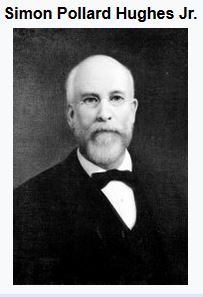
Blazons & Genealogy Notes
1) (Gwerclas, in Edeirnion, co. Merioneth; derived from Owain Brooyntyn, Lord of Edeirnion, Dinmael, and Abertenant, in Powys-Fadoc). Ar. a lion ramp. sa. armed and langued gu. Crests—1st, Hughes, of Gwerclas: A demi lion ramp. sa. issuing out of a ducal coronet; 2nd, Rogers, of Bryntangor: A boar pass, fretty gu.; 3rd: On a chapeau az. turned up erm. a dragon gu. gorged wich an ancient regal crown, cognizance of the ancient Princes of Wales. Supporters—Dexter, a lion sa.; sinister, a dragon gu. Motto— Kymmer-yn-Edeirnion.
2) (Plas yn Diserth and Llewerllyd, co. Flint; derived by uninterrupted male succession from Cadwalladr, second son of Griffith ap Cynan, King of North Wales, and his second wife Dyddgy, dau. of Meredith ap Bleddtn ap Cynfyn, Prince of Powys). Gu. two lions pass. and a rose in chief ar. Crest (granted by St. George, Norroy, 1620, to William Hughes, Esq., of Llewerllyd)— Out of a coronet or, a demi lion ar. holding a rose gu. stem and leaves vert.
3) (Kinmel Park, co. Denbigh. The present representative, Hugh Robert Hughes, Esq., of Kinmel, Lord-Lieut. co. Flint, is nephew of William Lewis, first Lord Dinorben, and grandson of Rev. Edward Hughes, A.M., of Kinmel Park, by Mary Lewis, his wife, niece and heiress of William Lewis, Esq., of Llysdulas, co. Anglesea). Gu. two lions pass. and a rose in chief ar. Crest—Out of a ducal coronet or, a demi lion ramp. ar. holding betw. the paws a rose gu. slipped ppr. Motto—Heb Dduw heb ddim, Duw a digon.
4) (Tregib, co. Carmarthen). Gu. a lion ramp. or, in a true love knot ar. betw. four fleurs-de-lis, their stalks bending towards the centre of the second.
5) (Tregib, co. Carmarthen). Gu. a lion ramp. or, in a true love knot ar. betw. four fleurs-de-lis, their stalks bending towards the centre of the second. Crests: 1st, A Talbot passant, for Hughes, 2nd; A goat passant, for Williams; 3rd, A raven proper, for Gwynne.
6) (Alltlwyd, co. Cardigan). Ar. a chev. betw. three fleurs-de-lis az. on a chief of the last a mullet pierced of the field. Crest—On a chapeau gu. turned up erm. a demi lion ramp. holding In the dexter paw a fleur-de-lis. Motto—Y cyfiawn sydd by megia Llew.
7) (Plas Coch, co. Anglesea). Ar. a chev. erm. betw. three Cornish choughs ppr. each holding in the beak an erm. spot. Crest—A Cornish chough ppr. Motto—Duw a ddarpar i’r brain.
8) (Bodwryn, co. Anglesea). Ar. an eagle with two heads displ. sa. Crest—An eagle’s head erased sa. in the beak a brand raguly of the same fired gu. Motto—A fynno Duw derfyd.
9) (Ystradd, co. Denbigh). Or, three lions couchant sa. Crest—A lion couchant sa.
10) (Brecon). Sa. a chev. betw. three fleurs-de-lis or. Crest—An arm in armour ppr. holding a fleur-de-lis ar.
11) (Trostrey, co. Monmouth; borne by Robert Hughes, Esq., of Cheltenham). Sa. a chev. betw. three fleurs-de-lis ar. Crest—A hand in armour ppr. couped above the wrist lying fesseways, and holding in the hand a fleur-de-lis ar.
12) (East Bergholt, co. Suffolk, bart.). (Wells, co. Somerset). Az. a lion ramp. or. Crest—A lion couchant or.
13) (Donnington Priory, co. Berks). Quarterly, 1st and 4th, sa. a fesse cotised betw. three lions’ heads erased ar.; 2nd, az. three arrows, points downwards or, on a chief of the second three Moors’ heads couped sidefaced sa.; 3rd, ar. a chev. erm. betw. three unicorns’ heads capped sa.
14) (Rev. Hugh Hughes, of Nuneaton, co. Warwick). Erm. a lion ramp. gu. a bordure sa. fretty or. Crest—In front of a griffin’s head erased sa. a fret or.
15) (William Hughes Hughes, Esq., of Clapham Common, co. Surrey, and Ryde. Isle of Wight, M.P. for Oxford in four Parliaments, eldest son of John Hewitt, Esq., of Clapham, by Sophia his wife, only child of the late William Hughes, Esq., of Clapham). Ar. on a pile engr. az. betw. two escallops in fesse gu. a lion ramp. of the field. Crest—In front of a staff raguly fesseways ppr. and thereon a lion couchant az. holding betw. the paws an escallop, as in the arms, a tilting spear erect or. Motto—Semper vigilans.
16) (Sherdley Hall, co. Lancaster). Gu. two lions pass. in pale and a rose in chief ar. Crest—Out of a ducal coronet or, a demi lion ramp. ar. holding betw. the paws a white rose ppr. Motto—Heb Dduw heb ddim, Duw a digon.
17) (Maidstone, co. Kent). Gu. on a bend ar. three fleurs-de-lis, in chief a demi lion ramp. Crest—On a chapeau gu. turned up erm. a demi eagle with wings elevated.
18) (Middleton Stoney, co. Oxford; Michael Hughes, son of John Hughes, descended from co. Carnarvon. Visit. 1634). Gu. on a bend betw. two demi lions ramp. ar. three fleurs-de-lis sa. Crest—A heron ar. beaked gu.
19) (co. Northampton). Ar. on a bend gu. betw. two demi lions ramp. couped ppr. three fleurs-de-lis or.
20) Ar. a chev. betw. three fleurs-de-lis gu. Crest—A lion ramp. or, holding a thistle slipped ppr.
21) Gu. a fret ar. on a canton or, a pheon of the field.
22) Ar. fretty gu. a canton erm.
23) (Archerstown, co. Tipperary). Gu. on a chev. ar. betw. three griffins’ heads erased or, three mullets az. Crest—A demi griffin or. Motto—Non sibi sed patriae.
24) (confirmed to Sir Frederic Hughes, Knt., K.L.S., eldest surviving son of Robert Hughes, Esq., of Ely House, co. Wexford, and the other descendants of his grandfather). Or, on a chev. sa. betw. three griffins’ heads erased gu. a fleur-de-lis betw. two mullets of the field. Crest—A griffin’s head erased gu. holding in the beak a fleur-de-lis or. Motto—Verus amor patriae.
25) (Reg. Ulster’s Office). Gu. a chev. betw. three lions ramp. or. Crest—A lion ramp. ar.
26) (Wells, co. Somerset; Sir Thomas Hughess, Knt., of Wells, knighted at Whitehall, 1619, son of Thomas Hughes, or ap Hugh, and grandson of Hugh ap John ap Jenkin, descended from Gwaituroyd, Prince of Cardigan. Visit. Somerset, 1623). Quarterly, 1st, az. a lion ramp. or, for Morien, son of Mrgenat: 2nd, or. a lion ramp. sa.; 3rd, az. three fleurs-de-lis or, for Ynes, King of Gwent; 4th, az. a fesse or, betw. three horses’ heads ar., for Rice ap Marcham; 5th, az. a lion statant reguard. or, for Llewellyn; 6th, az. a chev. erminois betw. three goats’ heads erased or, for iorworth.
27) (Wales) Ar. an eagle, displayed, with two heads sa.-Crest, an eagle’s head, erased, sa. holding in his beak a staff, raguly, gu. enflamed ppr.
28) (Scotland, originally Wales) (Borne by John Hughes, Esq. Civil Engineer of Chester, 1825) Quarterly ; first, bendy sinister of fourteen, or and vert, over all a lion, rampant, gu. ducally crowned of the first ; second, ar. six fleurs-de-lis, three, two, and one, within a double tressure, flory, counterflory, az. ; third, gu. a chev. betw. three unicorns, salient, ducally gorged or; fourth, erminois, an eagle, displayed, or.-Crest, out of a ducal coronet, an unicorn’s head ar.
29) (Wales, borne by Col. Hughes, M.P. of Kimmel-Park, St. Asaph, 1826) 1st and 4th, gu. two demi lions, passant, betw. as many roses, all in pale, ar.; 2nd and 3rd, quarterly, first, az. a chev. betw. three lions, rampant, or; second, or, on a bend sa. three men’s heads, in profile, couped at the neck ppr. – Crest, out of a ducal coronet, composed of a plain circle of gold, surmounted by four pearls, a demi lion ar. holding, in his paws, a rose gu.
30) (of Middleton Stoney, Oxon) (descended from Hughes of Caernarfon) Argent, a lion rampant sable, armed and langued, gules.
31) (of Gwerclas, Merionethshire) Argent, a lion rampant sable, armed and langued, gules.
32) (Breconshire). Sable, a chevron betw. three fleurs-de-lis or.
33) (Hughes of County Wexford) Or, on a chevron sable, between three griffins’ heads erased gules a fleur-de-lis between two mullets pierced or on a field appended below the shield, the Persian order of Lion Sun, and the Crimean and Turkish medals. Crest: A griffin’s head erased gules holding in the beak a fleur-de-lis or. Motto: Verus amor patriae.
34) (Hughes of Denford) Sable in chief two staves in saltire or, pendant from each a banner argent chared with a cross pate throughout gules, and in base upon water barry wavy proper a lymphad with sail set of the third. Crest: A ship’s wheel or, charged in the centre with a fountain. Motto: Pro deo et patria.
35) Quarterly, 1. Azure, a lion rampant or (Hughes); 2. Gules, a lion rampant reguardant or (Elistan Glodrydd); 3. Azure, three crowns in pale or (Beli Mawr); 4. Per bend sinister ermine and ermines, a lion rampant or (Tudor Trevor); 5. Or, a lion rampant reguardant sable (Gwaeth Voyd); 6. Per pale azure and sable, three fleurs-de-lis or (Ynyr, King. of Gwent); 7. Sable, a chevron between three goats’ heads erased or (Ithel Velyn); 8. Azure, a lion cowed passant guardant or (Llewellyn Aur Dorchog). They resided at The Red House, Yelverton, in South Devon.
36) (co. Lincoln). Az. a saltire erm. betw. four fleurs-de-lis or.
37) Az. a chev. engr. betw. three leopards’ faces or, langued ar.

